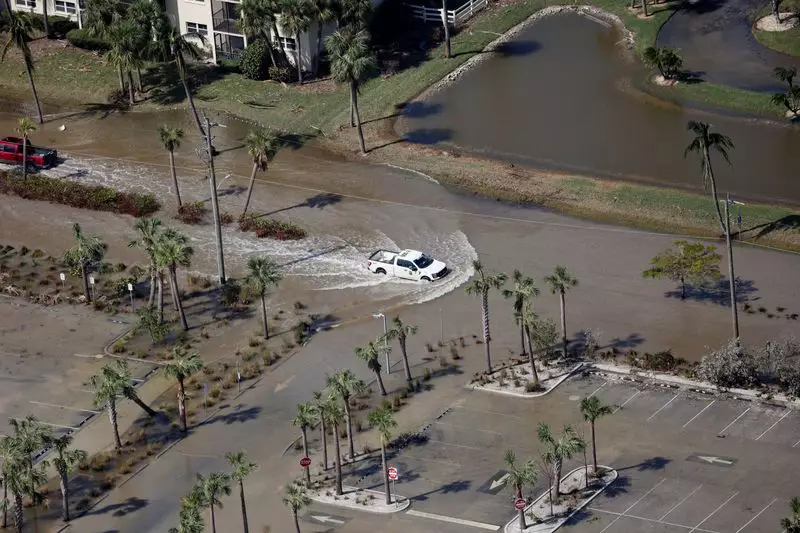On an ordinary Thursday in October, Hurricane Milton unleashed chaos upon Florida, transforming tranquil neighborhoods into sites of destruction and despair. As the storm made its way across the state, it produced at least 27 tornadoes that wreaked havoc in communities, claiming the lives of at least 10 individuals and pushing essential services to their breaking point. Officials reported that the greatest devastation occurred in St. Lucie County, where tornadoes swept through senior living communities, underscoring the vulnerability of certain populations during disasters.
Residents recount harrowing tales of survival amid the storm’s ferocity. One woman, Crystal Coleman, found herself barricaded in a bathroom with her teenage daughter as the tempest tore roofs from homes and hurled debris like confetti. Her visceral comments—“It felt like I was in a movie” and “I felt like I was about to die”—give voice to the raw fear experienced by countless others during the disaster. This emotional gravity serves as a reminder of nature’s indiscriminate power, casting a somber reflection on the perils faced by those caught in Milton’s path.
In the wake of the hurricane, Florida’s infrastructure bore the brunt of the damage. As millions were left without electricity, a sense of urgency emerged in restoring basic services. Reports indicated that over 3.2 million homes and businesses were in darkness, with many families still wrestling with lingering outages from Hurricane Helene just two weeks prior. Such disruptions can heighten the sense of isolation and helplessness among affected residents.
Compounding the crisis was the visible destruction in various locales, including the iconic Tropicana Field in St. Petersburg. The stadium sustained significant damage, with its fabric roof shredded and thousands of cots set up on the field for first responders and displaced residents. This duality of the stadium’s use—both as an entertainment venue and an emergency shelter—illustrates the community’s resilience in the face of adversity.
Furthermore, the devastation has sparked discussions about the reliability of local infrastructure and emergency communications. The state’s ability to inform residents of impending threats and provide adequate responses remains at the forefront of the conversation, with many questioning why some families remained unaware of evacuation orders prior to Milton’s onslaught.
In the aftermath, state and federal officials are navigating a complex recovery landscape, balancing immediate emergency responses with long-term rebuilding initiatives. Governor Ron DeSantis cautiously noted that while Florida avoided a “worst-case scenario,” significant damage persisted and flooding remained a pressing issue. Alongside him, U.S. Homeland Security Secretary Alejandro Mayorkas highlighted that proactive evacuation measures likely saved lives, as evidenced by the more than 90,000 individuals who utilized emergency shelters.
Efforts to gauge the extent of natural disasters like Milton require collaboration and swift action, particularly between federal entities such as FEMA and state agencies. FEMA’s head, Deanne Criswell, indicated that most of the reported destruction was due to tornadoes rather than storm surge, a silver lining amid a disastrous episode. Both federal and state officials face mounting pressure to secure disaster relief funding, particularly as President Biden voiced the necessity for Congress to address the consequences of natural disasters in light of recent events.
As Florida grapples with the ramifications of Hurricane Milton, it is essential to reflect on the lessons gained from such catastrophic events. The narrative of survival and community spirit shines through even the darkest moments. The stories of residents who braved the storm with courage and resilience provide a poignant testament to human tenacity.
Future preparedness hinges on adapting strategies to bolster emergency response systems, enhancing community awareness of evacuation protocols, and ensuring swift restoration of essential services. As people rebuild their lives, maintaining a focus on mental health support and resources will also be crucial to aid communities in recovering emotionally from the trauma inflicted by storms like Milton.
While Hurricane Milton caused extensive damage and irreversible loss, it also affirmed the strength of communities united in the face of adversity. As residents step into the recovery phase, their stories become woven into the larger fabric of resilience that defines Floridians—an enduring testament to their ability to weather life’s storms, both literal and metaphorical.

